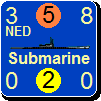Shannon V. OKeets
Posts: 22095
Joined: 5/19/2005
From: Honolulu, Hawaii
Status: offline

|
quote:
ORIGINAL: Extraneous
quote:
ORIGINAL: Shannon V. OKeets
First off, the rules say absolutely nothing about trains or rail cars. And as someone who worked with railroads for several years, I can assure you that putting coal and iron ore into passenger train cars doesn't work very well. Oil would be even messier.
WHAT Now a rail move is not a rail move Now a rail move is not a rail move 
The rules being discussed are "Railway supply paths", "11.10 Rail movement", and "Transporting resources by rail".
So in your experience with railroads:
There are an infinite number of railroad crews for the engines and trains.
Railroad engines are unable to uncouple railcars and re-couple to a different type of railcars.
Railroad tracks (rail lines) can only support one type of cargo.
It must have been a plush railroad company you worked for that could do that on Hawaii here on the mainland none of this is true.
There aren't an infinite number of railroad crews for the engines and trains.
Railroad engines are able to uncouple railcars and re-couple to a different type of railcars.
Railroad tracks (rail lines) can support more than one type of cargo.
I have said nothing about railcars but I have been discussing rail lines.
I say almost nothing about naval operations, because I have no experience with them.
But when it comes to railroads, I have a better understanding than most laymen.
The locomotives for passenger trains are often times different than those used for hauling freight. Freight trains haul much heavier loads and go much slower. And the track beds for passenger trains are often separate from the track beds for freight trains. The former run at higher speeds so when going around curves the cant of the track is different. Freight rail beds take much harder punishment given the weight of the cargo. There are also differences in the signalling system having to do with the braking distance for the different trains. I can't go into all the differences here about railroad signalling systems but I wrote a program in the 1970's to simulate the different proposed designs for the northeast corridor (Washington D. C. to Boston). There are a lot of variables involved.
So yes, rail moves are not universally the same. When I was working on the NE corridor project, the trains going into New Haven from the south used AC power, and those above that were diesel (or maybe they were running on DC power?). Either way, the locomotives had to be changed at New Haven.
You would really not like riding in a passenger train that was using the freight rail bed. Coal never complains but human passengers tend to not like being thrown up and down and left and right continuously.
You should accept that fact that WIF handles rail movement as an abstraction. In fact it has 3 different abstractions for simulating the movement of supplies, troops, and raw materials.
---
An even more glaring weakness in the game's simulation of the real world is the definition of minor and major ports. Historically many of them were dedicated to either military or commercial vessels. In WIF all ports can be used for either purpose.
---
In summation (I hope), the rules are the rules. To try to finesse a deeper understanding of them by comparing them to the real world either does not work at all, or entails a lot of effort for very little - if any - gain.
_____________________________
Steve
Perfection is an elusive goal.
|
 Printable Version
Printable Version












 New Messages
New Messages No New Messages
No New Messages Hot Topic w/ New Messages
Hot Topic w/ New Messages Hot Topic w/o New Messages
Hot Topic w/o New Messages Locked w/ New Messages
Locked w/ New Messages Locked w/o New Messages
Locked w/o New Messages Post New Thread
Post New Thread